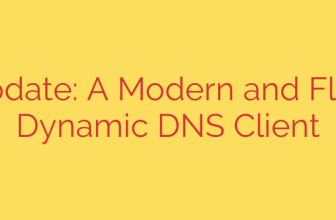
Discover Synex: A Minimalist Debian-Based OS for Peak Performance
In a world where operating systems are often cluttered with non-essential features and pre-installed software, a minimalist approach offers a refreshing return to efficiency and control. For users who demand speed, stability, and a system built precisely to their specifications, Synex emerges as a powerful solution. This lean, Debian-based distribution strips away the bloat, providing a pristine foundation for you to build your perfect computing environment.
Synex isn’t just another Linux distribution; it’s a philosophy. It operates on the principle that the user should have complete control, starting with a core system that is lightweight, secure, and incredibly stable.
The Power of a Minimalist Debian Core
At its heart, Synex is built upon the rock-solid foundation of Debian, one of the most respected and reliable open-source projects in the world. This provides several immediate and significant advantages:
- Legendary Stability: By leveraging the Debian Stable branch, Synex inherits a codebase that has been rigorously tested, ensuring dependable performance for critical tasks.
- Vast Software Access: You gain full access to Debian’s extensive software repositories. With a simple
aptcommand, you can install thousands of applications, tools, and libraries, confident in their compatibility. - Unparalleled Security: The Debian project has a dedicated security team that provides timely updates and patches. Synex benefits directly from this robust security infrastructure.
The key difference lies in what Synex doesn’t include. Unlike mainstream distributions that come with a pre-selected desktop environment and a suite of applications, Synex provides only the essential command-line system. This minimalist approach results in a significantly smaller attack surface and incredibly low resource usage, making it an ideal choice for servers, containers, and older hardware.
Key Features That Set Synex Apart
Synex is carefully crafted for users who value simplicity and performance above all else. Here are the core features that define the experience:
- Feather-light Footprint: With a tiny installation size, Synex consumes minimal RAM and CPU resources. This leads to faster boot times and leaves more system power available for your actual applications.
- Total User Control: You begin with a clean slate. There are no pre-installed graphical interfaces or opinionated software choices. You decide exactly what gets installed, from the window manager to the web browser.
- Built for Performance: By eliminating unnecessary background services and applications, Synex ensures that your system’s resources are dedicated to the tasks that matter most to you.
- Pure Debian Compatibility: There are no proprietary tweaks or forks that could cause conflicts. Synex offers a pure Debian experience, ensuring that any guide or solution applicable to Debian will work seamlessly.
Who Should Use Synex?
While any Linux user can benefit from its efficiency, Synex is particularly well-suited for certain types of users:
- System Administrators and DevOps Professionals: Perfect for creating lean, specialized servers and container base images that are both secure and easy to manage.
- Developers: Provides a clean, predictable, and distraction-free environment for building and testing software without the overhead of a full desktop OS.
- Linux Enthusiasts and Power Users: A dream platform for those who love to customize every aspect of their system and build a truly personal computing environment from the ground up.
- Users with Older Hardware: An excellent way to breathe new life into aging laptops and desktops that can no longer handle the demands of modern, resource-heavy operating systems.
Getting Started: Your First Steps with Synex
Embracing minimalism is a straightforward process. Once you’ve completed the simple, text-based installation, you’re ready to start building. Here are some actionable tips to get you going:
Update Your System: The very first step after installation should always be to ensure your system is current. Run the following command to fetch the latest package lists and apply any security updates:
sudo apt update && sudo apt upgrade -yChoose Your Interface: For a graphical environment, you’ll need to install a display server (like Xorg) and either a lightweight window manager (such as Openbox or i3) or a full desktop environment (like XFCE or KDE Plasma). For example, to install the lightweight XFCE desktop:
sudo apt install task-xfce-desktopInstall Essential Software: Now is the time to install the tools you need. This could include a web browser, a text editor, and other productivity applications. The beauty of Synex is that you only install what you will actually use, keeping your system clean and efficient.
In conclusion, Synex stands as a testament to the power of simplicity. By combining the legendary stability of Debian with a strict minimalist philosophy, it delivers a fast, secure, and highly customizable operating system for users who know exactly what they want. If you’re ready to escape the bloat and build a system that is truly your own, Synex offers the perfect foundation.
Source: https://www.linuxlinks.com/synex-debian-based-distribution/








